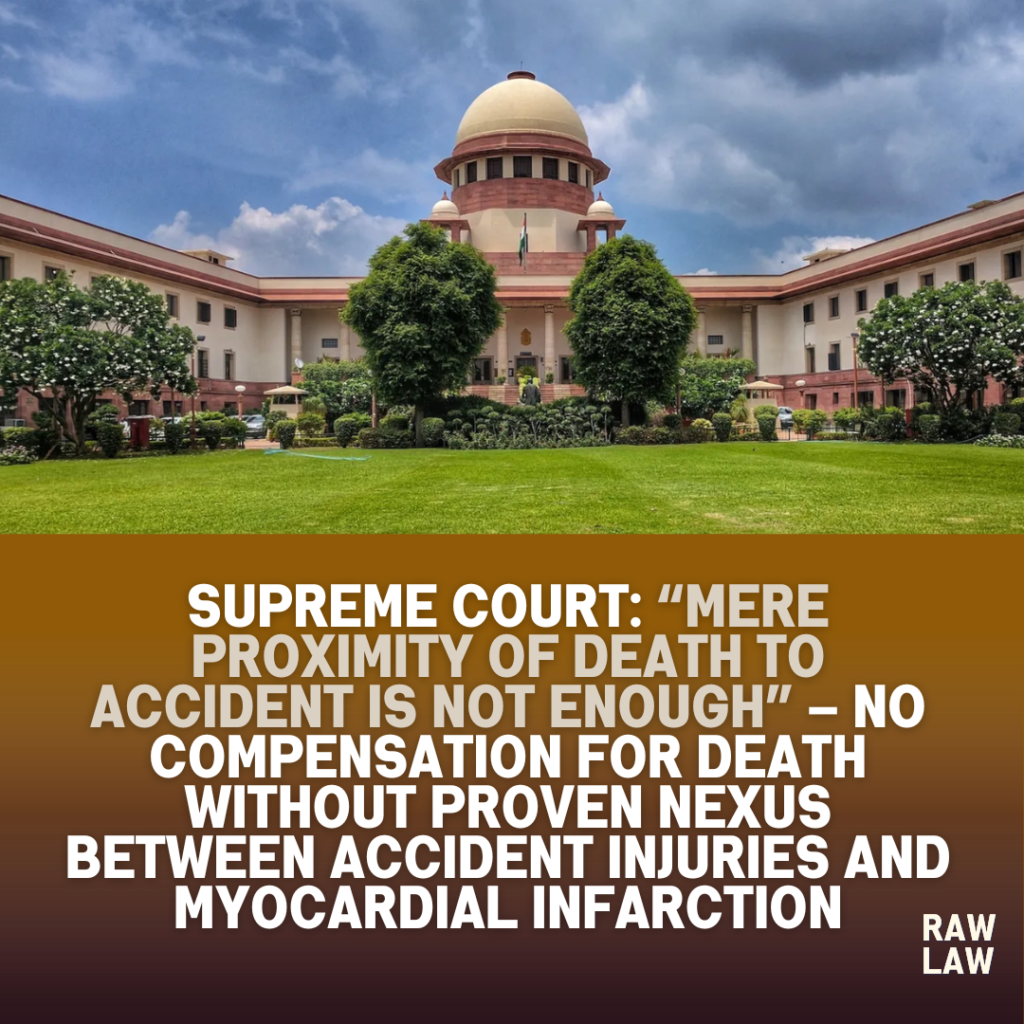Court’s Decision
The Supreme Court dismissed the appeal filed by the dependents of a deceased excise guard seeking compensation for his death under the Motor Vehicles Act. The Court upheld the High Court’s ruling that the death, which occurred five months after the accident due to pulmonary embolism/acute myocardial infarction, could not be conclusively linked to the injuries sustained in the motor accident. The Court observed:
“Merely by reason of the proximity of the accident and the death, it cannot be assumed, without clear evidence, that the death occurred as a result of the injuries sustained in the accident.”
Haseena
Facts
The deceased met with a motorbike accident on 29 April 2006, sustaining fractures to the right foot and little finger, along with wounds at the fracture site. He was hospitalized until 3 May 2006 and thereafter treated as an outpatient until August 2006. The injuries led to a non-healing ulcer on the right foot, requiring skin grafting.
On 18 September 2006, nearly five months later, he was admitted to a higher medical centre for surgery. Though the grafting was performed successfully, he developed sudden breathlessness and restlessness, and died the same day. The cause of death was reported as pulmonary embolism/acute myocardial infarction.
The Tribunal accepted that the death was a direct result of accident injuries and awarded compensation. However, the High Court reversed this, holding that the nexus between accident injuries and death was not conclusively proven. The dependents appealed to the Supreme Court.
Issues
- Whether the deceased’s death, five months after the accident, was directly attributable to the injuries sustained in the accident.
- Whether the claimants were entitled to compensation for death under the Motor Vehicles Act despite the long gap and medical complications.
- What evidentiary standard applies in proving causal connection between accident injuries and subsequent death.
Petitioner’s Arguments
The appellants (wife, minor child, and mother of the deceased) contended that the non-healing ulcer and surgery were directly linked to the accident injuries. They emphasized that the deceased had no prior heart ailments or hypertension, and Exhibit A-1 certificate issued by the plastic surgeon (PW-1) confirmed death due to pulmonary embolism following prolonged treatment for accident injuries.
They argued that the Tribunal correctly recognized the chain of causation between the accident and the death, and that the High Court erred by treating intervening medical complications as independent of the accident.
Respondent’s Arguments
The insurance company contended that the injuries from the accident were not serious and that the death resulted from independent medical conditions including diabetes, high cholesterol, and blood pressure. They highlighted PW-1’s cross-examination, where the doctor admitted the deceased had mild hypertension and diabetes, which increased the risk of heart attack.
It was argued that no postmortem was conducted, leaving the actual cause of death uncertain, and that the five-month gap broke the chain of causation. Thus, no liability could be fastened on the insurer for death compensation.
Analysis of the Law
The Court reiterated that compensation under the Motor Vehicles Act requires proof of causation between accident injuries and death. While strict criminal standards are unnecessary, at least a preponderance of probability must exist.
The Court noted that the Tribunal had inferred causation merely from proximity and absence of prior ailments, whereas the High Court carefully weighed medical testimony, including PW-1’s admissions regarding diabetes, high cholesterol, and strain patterns suggesting cardiac risks. Without a postmortem, causation remained speculative.
Precedent Analysis
- Workmen v. American Express International Banking Corp. (1985) 4 SCC 71 – Welfare statutes must be liberally construed, but inference cannot substitute for proof. Applied to highlight that beneficial interpretation has limits.
- New India Assurance Co. Ltd. v. Nusli Neville Wadia (2008) 3 SCC 279 – Doctrine of purposive interpretation in welfare laws. Distinguished here as causation must still be medically supported.
- Case law on motor accident claims – The Court reinforced that causal nexus between accident and death is essential, and speculative links cannot suffice.
Court’s Reasoning
The Supreme Court found the High Court’s evaluation of evidence sound. It held that:
- The injuries sustained in the accident were not severe.
- The deceased suffered from diabetes, mild hypertension, and high cholesterol, all risk factors for myocardial infarction.
- The non-healing ulcer could have been due to diabetes, and death could equally have resulted from cardiac complications unrelated to the accident.
- Absence of postmortem eliminated certainty.
Thus, the claimants failed to establish even a preponderance of probability linking the death to the accident.
Conclusion
The Supreme Court dismissed the appeal, affirming that the dependents were not entitled to death compensation, though the claim for injuries sustained in the accident was recognized. The judgment reinforces the principle that welfare intent of motor accident law cannot override the need for proven causal nexus between accident injuries and death.
Implications
This ruling underscores that courts cannot award compensation for death in motor accident claims solely on temporal proximity. Medical evidence must establish a clear link. The decision sets a precedent that in cases involving pre-existing conditions, claimants must prove that the accident injuries substantially contributed to the death, failing which compensation for death will not be granted.
FAQs
1. Can death occurring months after an accident be compensated under the Motor Vehicles Act?
Yes, but only if a clear medical nexus is established between the accident injuries and the death. Mere proximity is insufficient.
2. Why was compensation denied in this case?
Because medical evidence showed risk factors like diabetes and hypertension, absence of postmortem, and lack of proof that accident injuries directly caused the myocardial infarction.
3. Does welfare interpretation always favour claimants in motor accident cases?
No. Courts adopt a liberal approach but still require proof of causation. Welfare intent cannot replace medical certainty.
